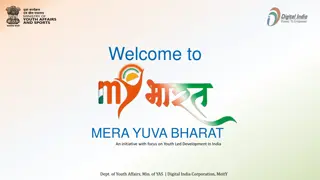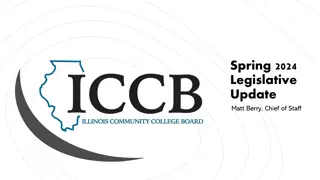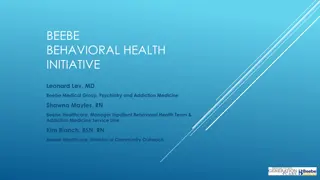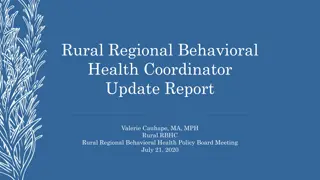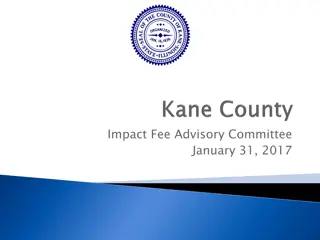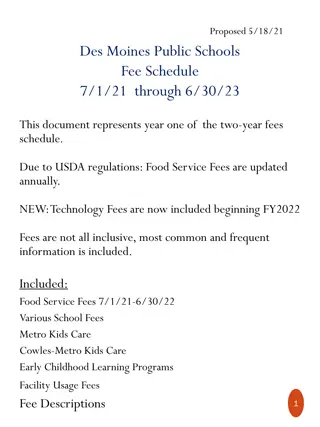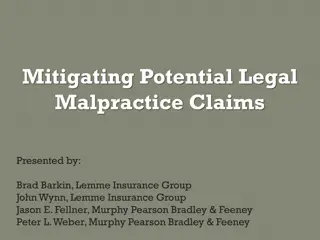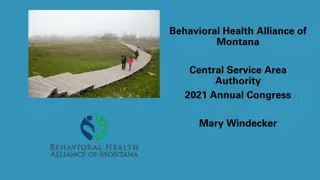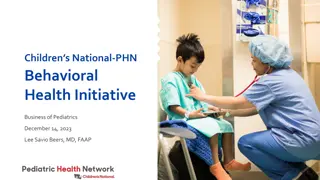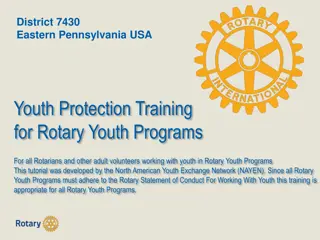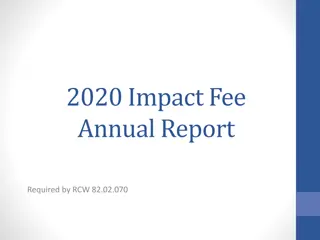Youth Behavioral Health Initiative - Fee Schedule Working Group
This document provides an overview of the Children and Youth Behavioral Health Initiative Fee Schedule Working Group session, detailing confidential and preliminary information on next steps, stakeholder engagement, and considerations for designing a school-linked fee schedule to support CYBHI. The document outlines the purpose, participants, agenda, and discussions held during the session, emphasizing the confidential and pre-decisional nature of the content.
Download Presentation

Please find below an Image/Link to download the presentation.
The content on the website is provided AS IS for your information and personal use only. It may not be sold, licensed, or shared on other websites without obtaining consent from the author.If you encounter any issues during the download, it is possible that the publisher has removed the file from their server.
You are allowed to download the files provided on this website for personal or commercial use, subject to the condition that they are used lawfully. All files are the property of their respective owners.
The content on the website is provided AS IS for your information and personal use only. It may not be sold, licensed, or shared on other websites without obtaining consent from the author.
E N D
Presentation Transcript
Children and Youth Behavioral Health Initiative Fee schedule working group session 1 October 3, 2022 Information contained in this file is confidential, preliminary, and pre-decisional
Information contained in this file is confidential, preliminary, and pre-decisional Purpose: The purpose of this document is to present next steps for the Office of Strategic Partnership s BH Fee Schedule workstream as part of the Children and Youth Behavioral Health Initiative. The materials are meant to provide a non-exhaustive fact base around potential stakeholder engagement and preliminary materials for the fee schedule. This document was created at the request of DHCS Office of Strategic Partnerships. Sources of insight include working sessions with OSP, the DHCS July memo on the BH Fee Schedule, and inputs from CalHHS and other department teams. The approaches and considerations included in this document are preliminary and may be further developed based on additional inputs from OSP, broader DHCS, CalHHS and other departments. 2
Information contained in this file is confidential, preliminary, and pre-decisional DRAFT AS OF 09/23/22 Welcome! Please add your name and role in the meeting chat! This Working Group will focus on supporting the design of a school-linked fee schedule in support of CYBHI. The group includes a wide range of perspectives, including: Xx Higher Education (including school-linked providers) Xx K-12 (including school-linked providers) Xx Other Organizations (e.g. ,NGOs, advocates) Xx Medi-Cal Managed Care Plans Xx Counties represented across all major CA regions Xx Xx CBOs and Afterschool Programs Xx County Health Plans Commercial Health Plans 3 Source: Responses to Working Group applications and nominations
Information contained in this file is confidential, preliminary, and pre-decisional DRAFT AS OF 09/23/22 Topic Activities Time 1 Overview and introductions Review today s agenda and get to know each other 20 mins Today s Agenda Review background (e.g., legislative requirements, impact on funding, etc.) Align on role of workgroup and working norms 2 Vision for the fee schedule and role of working group 30 mins Break 5 mins Share current hypothesis on scope of services Discuss open design questions around policy and operations in breakout rooms 55 mins 3 Policy and operational considerations Review plan and cadence for following sessions over the next 3 months, including pre-work for next session 10 mins 4 Next steps 4
Information contained in this file is confidential, preliminary, and pre-decisional DRAFT AS OF 09/23/22 Topic Activities Time 1 Overview and introductions Review today s agenda and get to know each other 20 mins Today s Agenda Review background (e.g., legislative requirements, impact on funding, etc.) Align on role of workgroup and working norms Vision for the fee schedule and role of working group 30 mins 2 Break 5 mins Share current hypothesis on scope of services Discuss open design questions around policy and operations in breakout rooms 55 mins 3 Policy and operational considerations Review plan and cadence for following sessions over the next 3 months, including pre-work for next session 10 mins 4 Next steps 5
Information contained in this file is confidential, preliminary, and pre-decisional DRAFT AS OF 09/23/22 1. Potential success from today s discussion Share vision and context for a school-linked fee schedule for BH services 1 Align on working group charter, including objectives, norms and expectations 2 Discuss major operational questions for the school- linked fee schedule 3 6 Source: Discussion with OSP, 09/07/2022
Information contained in this file is confidential, preliminary, and pre-decisional DRAFT AS OF 09/23/22 What word describes something that excites you about the potential future-state of a school-linked fee schedule? 1. Word Cloud Exercise (1 of 2) To do: embed Poll Everywhere word cloud Source: DHCS input
Information contained in this file is confidential, preliminary, and pre-decisional DRAFT AS OF 09/23/22 1. Phrase wall exercise (2 of 2) What is a worry/concern you have about implementing a new school-linked fee schedule? To do: embed Poll Everywhere phrase wall Source: DHCS input
Information contained in this file is confidential, preliminary, and pre-decisional DRAFT AS OF 09/23/22 Topic Activities Time 1 Overview and introductions Review today s agenda and get to know each other 20 mins Today s Agenda Review background (e.g., legislative requirements, impact on funding, etc.) Align on role of workgroup and working norms 2 Vision for the fee schedule and role of working group 30 mins Break 5 mins Share current hypothesis on scope of services Discuss open design questions around policy and operations in breakout rooms 55 mins 3 Policy and operational considerations Review plan and cadence for following sessions over the next 3 months, including pre-work for next session 10 mins 4 Next steps 9
Information contained in this file is confidential, preliminary, and pre-decisional DRAFT AS OF 09/23/22 2. Overview of the Children and Youth Behavioral Health Initiative (CYBHI) The goal of the Children and Youth Behavioral Health Initiative is to address the behavioral health challenges facing children and youth by reimagining the systems that support behavioral health and wellness for children, youth, and their families The initiative will take a whole system approach by creating cross-system partnerships involving stakeholders from the various systems that support children and youth behavioral health to ensure that the reimagined ecosystem is children and youth centered and equity focused 10 Source: California Health and Human Services Agency
Information contained in this file is confidential, preliminary, and pre-decisional DRAFT AS OF 09/23/22 2. The CYBHI vision is to reimagine behavioral health and emotional wellbeing Designed for Youth Advance by Youth Equity for ALL children, youth, and families in California by delivering equitable, appropriate, timely, and accessible mental health and substance use services and supports from prevention to treatment to recovery in an innovative, up-stream focused, ecosystem Start Early, Start Smart Free of Stigma Children and Youth Center around Right Time, Right Place Empower Families and Communities Source: California Health and Human Services Agency 11
Information contained in this file is confidential, preliminary, and pre-decisional DRAFT AS OF 09/23/22 2. Snapshot of stakeholder engagement to date In 2022 to date, DHCS and DMHC have engaged multiple stakeholder groups (including some participants from this Working Group) regarding school-linked services as a part of CYBHI, including: 8 Listening tours 5 Public-facing webinars 3 higher education roundtable discussions Conference with the County Behavioral Health Directors Association of California (CBHDA) Conference with the California Association of Health Plans (CAHP) and Local Health Plans of California (LHPC) Ongoing stakeholder engagement with K-12 partners through the Education Coalition We are excited to launch this workgroup, which is the first stakeholder group focused exclusively on the design of the school-linked fee schedule Feedback from these sessions has informed DHCS s understanding of current-state Behavioral Health offerings in school settings. 12 Source: DHCS Public Webinar
Information contained in this file is confidential, preliminary, and pre-decisional DRAFT AS OF 09/23/22 2. Current challenges and vision for the school-linked BH fee schedule Current challenges for school- linked BH services How the Fee Schedule aims to address current challenges Need for sustainable funding and resource allocation for services that CYBHI aims to promote and scale Insufficient provider capacity to provide and supervise services School-linked providers can bill to the fee schedule to fund services that are appropriate to provide in schools The fee schedule may include coverage for provider types not currently covered (e.g., BH Coaches) Administrative, logistical, legal, and financial burden from providing BH services, especially for small schools and school-linked providers The fee schedule uses a more approachable billing model to ease administrative burden of billing services and simplify contracting, rate negotiation, and navigation across delivery The fee schedule includes mechanisms for oversight and accountability into fee schedule design Concerns around fraud, waste and abuse Need to ensure improvement in equity of services Build funding sources for schools to be a stronger delivery hub that will reach students who are typically underserved by traditional healthcare delivery system 13 Source: DHCS 2022 stakeholder engagement sessions
Information contained in this file is confidential, preliminary, and pre-decisional DRAFT AS OF 09/23/22 2. Fee schedule working group charter Objectives and scope Member expectations The Working Group will: The Working Group will not Join all Working Group Sessions on-time Complete all pre-work and pre-reading before sessions as needed Do not multi-task during sessions Maintain confidentiality Provide input on current-state school- linked BH services billing / reimbursement / contracting processes, including potential challenges Offer perspectives on select design decisions, including (not exhaustive): What services are included in the fee schedule? Who is eligible to provide services? How are payments made through the fee schedule? Engage with other stakeholders on the fee schedule implementation plan Make final design decisions (DHCS and DMHC will decide) Directly shape decisions around other billing programs (e.g., LEA BOP) 14 Source: Discussion with OSP, 09/07/2022; 08/17/2022
Information contained in this file is confidential, preliminary, and pre-decisional DRAFT AS OF 09/23/22 2. Fee schedule working group norms and values Participatory Commit to participating in discussions, completing pre-work , and joining potential follow-up sessions Collaborative Work together to facilitate the program design by welcoming others perspectives and championing CYBHI Anchor discussion on problem solving and brainstorming potential solutions Activity: Use the Jamboardto add stickies with additional norms for the team, and mark the norms that resonate most with you Solution- oriented Open and exploratory Maintain a safe space for discussion, debate, and risk-taking Health impact- focused Center around the impact and outcomes of design decisions for children, youth, and families in California For discussion 15 Source: DHCS Think Tank sessions
Information contained in this file is confidential, preliminary, and pre-decisional 2. Preliminary topics for upcoming sessions Session topics, dates, and agendas may be subject to change DRAFT AS OF 09/23/22 Topics for future sessions Session 1 (10/3) Kickoff & Overview FSWG charter Fee schedule background and overview Policy and operational conditions and success factors Preview of upcoming sessions and scope of services discussion Session 2 (10/24) Scope of Services & Provider Network Updates and changes from previous session Provider network considerations, including enrollment and eligibility requirements Detail on scope of services Session 3 (11/7) Billing & Reimbursement Updates and changes from previous session Billing and reimbursement considerations Network oversight, including FWA considerations Session 4 (12/5) Implementation Post Session 4 Updates and changes from previous session Fee schedule implementation plan for 2024 Additional topics as- needed Additional, townhalls as-needed through Jan 2024 to flag consid- erations Topics for discussion 16 Source: Input from OSP, 09/07/2022
Information contained in this file is confidential, preliminary, and pre-decisional DRAFT AS OF 09/23/22 Topic Activities Time 1 Overview and introductions Review today s agenda and get to know each other 20 mins Today s Agenda Vision for the fee schedule and role of working group Review background (e.g., legislative requirements, impact on funding, etc.) Align on role of workgroup and working norms 30 mins 2 Break 5 mins Share current hypothesis on scope of services Discuss open design questions around policy and operations in breakout rooms 55 mins 3 Policy and operational considerations Review plan and cadence for following sessions over the next 3 months, including pre-work for next session 10 mins 4 Next steps 17
Information contained in this file is confidential, preliminary, and pre-decisional DRAFT AS OF 09/23/22 3. Overview of statutory requirements CYBHI Act Statutory requirements1 Additional factors 1. Develop and maintain a school-linked statewide fee schedule for outpatient mental health or substance use disorder provided to a student 25 years of age or younger at a school site Develop and maintain a school-linked statewide provider network of school site behavioral health counselors Require each commercial health plan AND the Medi-Cal managed care plans and Medi-Cal behavioral health delivery system, as applicable, to reimburse providers of medically necessary outpatient mental health or substance use disorder treatment provided at, or near, a school site to a student (age 25 or younger) who is an enrollee of the plan or delivery system Providers of medically necessary school-site services will be reimbursed, at a minimum, at the fee schedule rate regardless of network provider status (e.g., commercial plan coverage) Services provided as part of the fee schedule shall not be subject to copayment, coinsurance, deductible, or any other form of cost sharing2 2. 3. 1. 2. Source: DHCS Public Webinar See Children and Youth Behavioral Health Initiative Act, 5961.4 (a) (1) (4); See Health and Safety Code 1374.722 18
Information contained in this file is confidential, preliminary, and pre-decisional DRAFT AS OF 09/23/22 3. Preliminary view of scope of services1 to be covered Additional discussion planned for Workgroup 2 Prevention / early intervention: Care for a student to avoid or reduce the impact of a potential mental health condition or substance use disorder Ongoing Support: Support groups for students with a shared diagnosis and recovery groups for students in recovery from an SUD Coordination/ care management: activities by a team of providers and/or social support organizations to coordinate care and other services Treatment: Care for a student with an identified mental health condition or substance use disorder 19 1. CYBHI Act of 2021 Section 5961.4 (a)
Information contained in this file is confidential, preliminary, and pre-decisional DRAFT AS OF 09/23/22 3. Hypothesis for future-state school-linked fee schedule process flow Plan remits payment at (or above) the established rates State conducts ongoing audit and accountability School or school district enrolls as a provider Provider delivers services at or near school site Responsible party bills for services LEA bills for services Medi-Cal is payer (MCOs, Medi-Cal BH) Commercial plan is payor School or school district enrolls as a provider in the school-linked network and hires or contracts with medical practitioners eligible for reimbursement under the fee schedule School or school district provides or arranges for the provision of eligible medically necessary services on campus, off- campus, mobile, etc. State monitors for appropriate and timely reimbursement and fraud, waste, and abuse Third party billing entity bills 20 Source: DHCS
Information contained in this file is confidential, preliminary, and pre-decisional DRAFT AS OF 09/23/22 3. Design and operational considerations to be addressed Plan remits payment at (or above) the established rates State conducts ongoing audit and accountability School or school district enrolls as a provider Provider delivers services at or near school site Responsible party bills for services Designated party for fee schedule reimbursement (e.g., schools, LEAs, COEs, combination) Provider enrollment requirements and process Specific scope of services and benefits to be covered Eligible practitioners and enrollment requirements Designated central billing entity (e.g., LEAs, practitioners, schools) Supports and infrastructure needed for educational billing (e.g., potential role of third-party billing entity) Interaction with other BH funding streams Model for educational institution engagement with payers Payer provider network requirements for reimbursement Appropriate oversight of quality of services Appropriate fraud protection and network safety measures 21 Source: DHCS
Information contained in this file is confidential, preliminary, and pre-decisional DRAFT AS OF 09/23/22 You will each be assigned to join one of five pre-assigned breakout groups, each focused on a different step of the potential future-state process: Provider Enrollment Service delivery Billing Reimbursement Accountability and oversight 3. Breakout group discussions In your breakout groups, please 1. Select one team member who will report-out at the end 2. For each topic within your process step, use stickies on Jamboard to answer the following questions: What would you be most excited to see in the future state? What policy / operational factors need to be in place to realize that vision? What outstanding questions should DHCS and DMHC consider? 25 min 22
Information contained in this file is confidential, preliminary, and pre-decisional DRAFT AS OF 09/23/22 K 3. Breakout discussion activity: Provider enrollment 1 What would you be excited to see in the future state? 2 3 What policy / operational factors need to be in place to realize that vision? Outstanding questions and considerations for DHCS / DMHC Higher ed Topics for discussion Designated party for fee schedule reimbursement (e.g., schools, LEAs, COEs, combination) Medi Commercial payers Provider enrollment requirements and process Other ...other sub-topics 23 Source: DHCS
Information contained in this file is confidential, preliminary, and pre-decisional DRAFT AS OF 09/23/22 For each breakout group, the designated leader should share: 3. Read-out from breakouts What is one characteristic of the future state that makes you most excited? What are the 2 - 3 most critical factors for success to realize that vision? 15 min (3 minutes per group) 24
Information contained in this file is confidential, preliminary, and pre-decisional DRAFT AS OF 09/23/22 Topic Activities Time 1 Overview and introductions Review today s agenda and get to know each other 20 mins Today s Agenda Review background (e.g., legislative requirements, impact on funding, etc.) Align on role of workgroup and working norms Vision for the fee schedule and role of working group 30 mins 2 Break 5 mins Share current hypothesis on scope of services Discuss open design questions around policy and operations in breakout rooms 55 mins 3 Policy and operational considerations Review plan and cadence for following sessions over the next 3 months, including pre-work for next session 10 mins 4 Next steps 25
Information contained in this file is confidential, preliminary, and pre-decisional DRAFT AS OF 09/23/22 4. School-linked fee schedule implementation preliminary timeline Preliminary Timeframe Milestone Considerations 1. Fee schedule working group sessions 2. School-linked services grant rounds 3. Preliminary scope of services and design decisions for fee schedule finalized 4. Fee schedule published by healthcare finance team 5. Fee schedule goes live for Medi-Cal 6. Fee schedule goes live for Commercial Health Plans Oct-Dec 2022 Oct 2022-Feb 2023 Dec 2022 TBD Jan 2024 May include a phased roll-out TBD 26 Source: Input from OSP, 09/07/2022
Information contained in this file is confidential, preliminary, and pre-decisional 4. Preliminary topics for upcoming sessions Session topics, dates, and agendas may be subject to change DRAFT AS OF 09/23/22 Topics for future sessions Session 1 (today) Kickoff & Overview FSWG charter Fee schedule background and overview Policy and operational conditions and success factors Preview of upcoming sessions and scope of services discussion Session 2 (10/24) Scope of Services & Provider Network Updates and changes from previous session Provider network considerations, including enrollment and eligibility requirements Detail on scope of services Session 3 (11/7) Billing & Reimbursement Updates and changes from previous session Billing and reimbursement considerations Network oversight, including FWA considerations Session 4 (12/5) Implementation Post Session 4 Updates and changes from previous session Fee schedule implementation plan for 2024 Additional topics as needed Additional townhalls as needed through Jan 2024 to flag considerations Topics for discussion 27 Source: Input from OSP, 09/07/2022
Information contained in this file is confidential, preliminary, and pre-decisional In session 2, the FSWG will review mental health and substance use services for students 25 years of age or younger that can be provided by school-linked providers for inclusion in the statewide fee schedule.1 Sample pre-survey questions (subject to change): 4. Preview of pre-survey for session 2 Action needed: Please complete the pre-survey by end of day on Friday, October 14 1. Source: Fee Schedule Working Group Session 1 Pre-Survey, last edited 9/26/2022 CYBHI Act of 2021 Section 5961.4 (a) 28
Information contained in this file is confidential, preliminary, and pre-decisional Backup 29
Review: Fee Schedule stakeholder engagement plan Information contained in this file is confidential, preliminary, and pre-decisional Membership Total Members: 40-60 Stakeholder groups: ~1/3 education partners (including K-12 and higher ed. partners) ~1/3 BH providers BH providers (including K-12 and higher ed. partners) ~1/3 plans (Commercial, Medi- Cal MCPs, and County BH) Other relevant stakeholders Profiles sought: Technical roles, including Heads of Managed Care for MCPs / MHPs, School and Provider billing/admin leads Participant selection: DHCS and DMHC to identify participants through nominations from key partners (e.g., CAHP, LHPC, Ed. Coalition) and open application Key Dates Launch: Application opens; Emails sent to collaborators who will recommend potential invitees: Fri., 9/2 Responses expected back from collaborators who will recommend potential invitees: Wed, 9/7 Application closes: Mon., 9/12 Members notified of selection: Thur., 9/23 Sessions: Session 1: October 3, 3-5pm Session 2 (Higher ed.): October 10, 2:30-5:30pm Session 3 (K-12): November 7, 3-6pm Session 4: December 5, 3-6pm Potential additional ~bi-monthly townhall-style sessions in 2023 PRELIMINARY AS OF 09/08/2022 Objective The Working Group will: Provide input on current-state school-linked BH services billing / reimbursement / contracting processes, including potential challenges Offer perspectives on key design decisions in consideration for 2023: What services are included in the fee schedule? Who is eligible to provide services? How are payments made through the fee schedule? Gain opportunity to engage with other stakeholder groups on the fee schedule implementation plan The Working Group will NOT: Make the final key design decisions (DHCS and DMHC will decide) 30 Source: DHCS announcement
Information contained in this file is confidential, preliminary, and pre-decisional DRAFT AS OF 09/23/22 2. Potential impacts of a revised school-linked fee schedule on current billing processes What may change with a school- linked fee schedule A wider range of services from a wider range of providers may be billable Fee schedule may supersede existing payment mechanisms for school- linked BH services (e.g., the Medi-Cal fee schedule) Ed. institutions might not be subject to annual cost settlement processes for BH services (e.g., through LEA BOP) Educational institutions may need to maintain insurance status of all students Commercial plans could work more closely with educational institutions to coordinate billing What may stay the same with a school-linked fee schedule1 For payers (e.g., Medi-Cal, commercial plans, county BH): Current billing programs including LEA BOP and the Medi-Cal fee schedule remains in place and unchanged Payer designation by service remains in place State handles oversight against fraud, waste and abuse For educational institutions (e.g., LEAs, colleges, universities): Educational institutions or billing entities (in-house department or TPA) bill through traditional Medi-Cal FFS system for reimbursement Educational institutions are central providers w/ NPI and managing certification / compliance requirements, budget projection, DUA Educational institutions hire / contract with providers, provide services and pay for services prior to reimbursement 1. For educational institutions that are currently billing for behavioral health services 31 Source: Discussion with OSP, 09/07/2022; September DHCS Fee Schedule Memo
Information contained in this file is confidential, preliminary, and pre-decisional DRAFT AS OF 09/23/22 4. Instructions for Scope of Services breakout groups 1. Select a team member who will report-out at the end 2. Use stickies on Jamboard to answer these questions: What additional major categories of prevention & early intervention services should be offered in school-linked settings? Are any services on this list not appropriate to deliver in a school-linked setting? 20 minutes for discussion Are there specific policy and operational issues to consider in order to deliver and seek reimbursement for these services? What are specific examples of services to include within the category? What types of providers who typically provide the service? 32 Source: Discussion with OSP, 09/07/2022
Information contained in this file is confidential, preliminary, and pre-decisional DRAFT AS OF 09/23/22 4. Prevention & early intervention Potential category of service For discussion Screenings: administration of brief emotional or behavioral instruments or in- depth follow-ups to initial screenings (e.g., PHQ-9, ACES, S2BI, Brief screener for tobacco, alcohol, or other drugs) Health Education: instruction on behavioral health topics, coaching, goal setting (e.g., CHW services) Wellness and skill building: education and assistance for at-risk students to respond to behavioral health challenges (e.g., emotional regulation, mindfulness, distress tolerance) Student discussion/support groups: Peer support services for skill building, navigating challenging situations, coping with mental illness, and navigating the health care system (e.g., Identity support, NAMI on campus) Preventive wellness: individual or group risk factor reduction and behavior change interventions (e.g., Mind Matters) What additional major categories of prevention & early intervention services should be offered in school-linked settings? Are any services on this list not appropriate to deliver in a school- linked setting? Are there specific policy and operational issues to consider in order to deliver and seek reimbursement for these services? SUD pre-clinical intervention: a combination of screening combined with psychoeducation and/motivational interviewing (e.g., ASAM 0.5 programs and SBIRT) Sources: DHCS and DMHC stakeholder conversations Expert interviews Agency for Healthcare Research and Quality (AHRQ) 33
Information contained in this file is confidential, preliminary, and pre-decisional DRAFT AS OF 09/23/22 4. Prevention & early intervention Providers who typically provide service Specific examples of services to include within the category Potential category of service Screenings Health Education Wellness and skill-building Student discussion/support groups Preventive wellness SUD pre-clinical intervention Sources: DHCS and DMHC stakeholder conversations Expert interviews Agency for Healthcare Research and Quality (AHRQ) 34
Information contained in this file is confidential, preliminary, and pre-decisional DRAFT AS OF 09/23/22 4. Treatment Potential category of service Assessments: administration of an assessment (e.g., brief emotional/behavioral assessment, developmental, neurobehavioral, neuropsychological, SUD) Counselling/ Therapy: standard psychotherapy session (e.g., Individual, group or family psychotherapy) Medication management: pharmacological management including prescription use and review of medication Team consultation: consulting services provided to the treating provider or school-based team serving a student Family/dyadic services: services that support the family and therefore the health of the student (e.g., Parent Child Interaction Training, Positive Parenting Program) Mobile crisis services: community-based intervention designed to provide de-escalation and relief to individuals experiencing a behavioral health crisis wherever they are, including at school Evidence based therapy, CBT: Treatment delivered according to a defined CBT protocol (e.g., CBITS, MET-CBT, or trauma focused CBT For discussion What additional major categories of treatment services should be offered in school-linked settings? Are any services on this list not appropriate to deliver in a school- linked setting? Are there specific policy and operational issues to consider in order to deliver and seek reimbursement for these services? SUD treatment: ASAM level 1 service to treat a student s SUD (e.g., Counselling / Therapy; Medication Management; Psychiatric consultation) Sources: DHCS and DMHC stakeholder conversations Expert interviews Agency for Healthcare Research and Quality (AHRQ) 35
Information contained in this file is confidential, preliminary, and pre-decisional DRAFT AS OF 09/23/22 4. Treatment Specific examples of services to include within the category Providers who typically provide service Potential category of service Assessments Counselling/ Therapy Medication management Team consultation Family/dyadic services Mobile crisis services Evidence-based therapy, CBT SUD treatment Sources: DHCS and DMHC stakeholder conversations Expert interviews Agency for Healthcare Research and Quality (AHRQ) 36
Information contained in this file is confidential, preliminary, and pre-decisional DRAFT AS OF 09/23/22 4. Coordination/care management and ongoing support For discussion What additional major categories of coordination/ case management services should be offered in school-linked settings? Are any services on this list not appropriate to deliver in a school- linked setting? Are there specific policy and operational issues to consider in order to deliver and seek reimbursement for these services? Potential category of service Case management: clinical team conferences to discuss a patient s care Case consultation: consultation between a specialist and a teacher or other adult (e.g., interdisciplinary care team meeting) Referral coordination Social Determinates of Health (SDOH): connecting students to social supports which affect health status (e.g., connecting members to housing supports and food pantries definition) Diagnostic support group: support group for people with the same diagnosis (e.g., anxiety and depression support group) Recovery group: support group for people in recovery from an SUD (e.g., Alateen) Sources: DHCS and DMHC stakeholder conversations Expert interviews Agency for Healthcare Research and Quality (AHRQ) 37
Information contained in this file is confidential, preliminary, and pre-decisional DRAFT AS OF 09/23/22 4. Coordination/care management and ongoing support Providers who typically provide service Specific examples of services to include within the category Potential category of service Care management Case consultation Referral coordination Social Determinates of Health (SDOH) Diagnostic support groups Recovery groups Sources: DHCS and DMHC stakeholder conversations Expert interviews 38



